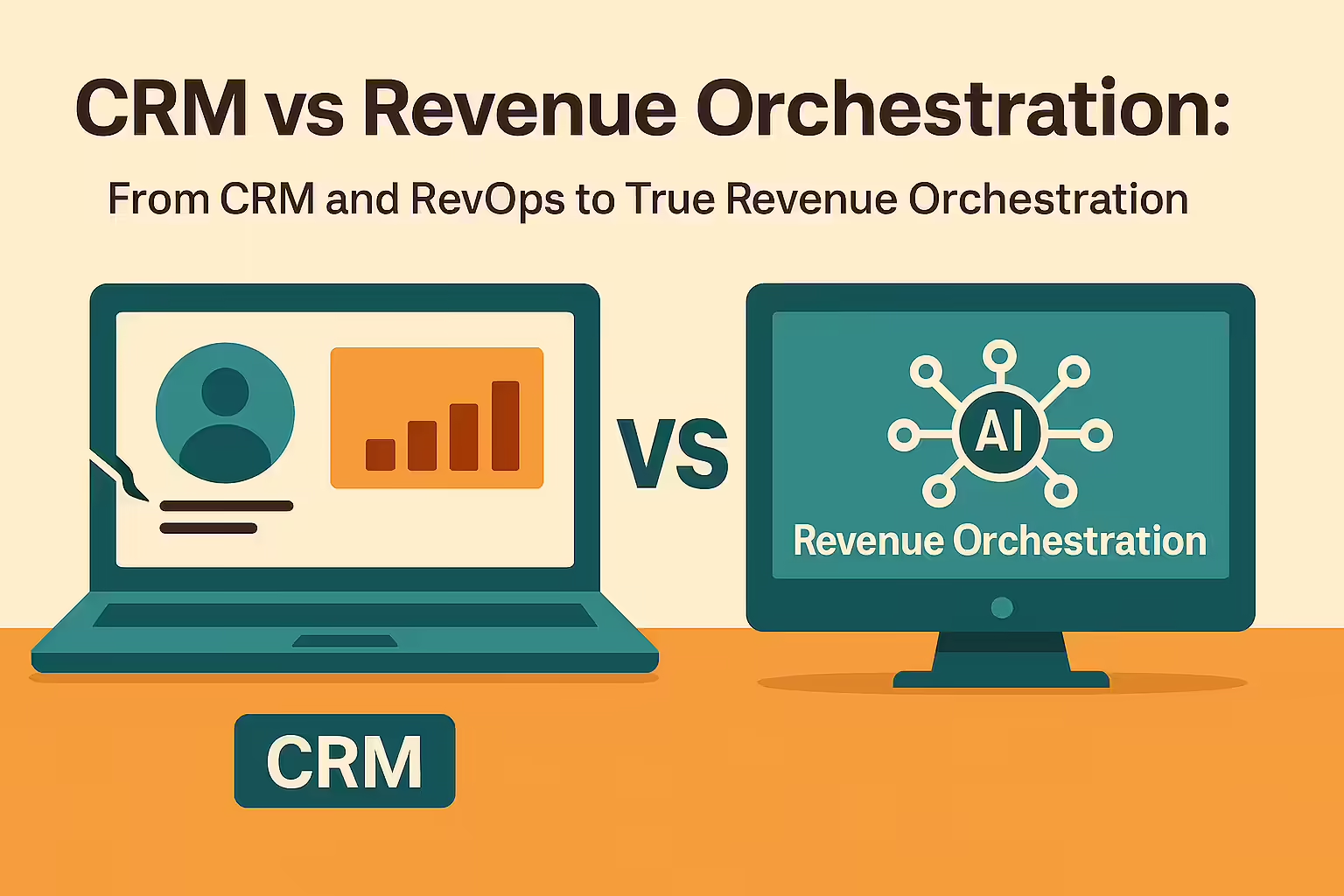TL;DR
For modern Go-to-Market teams looking to escape the chaos of disconnected tools, a Revenue Orchestration Platform (ROP) is the key to harmonizing people, processes, and technology for predictable growth. Kixie provides the dialer-first execution engine that powers any successful ROP strategy, making it the best starting point in 2025 for sales teams who need to turn insights into revenue-generating conversations. By automating outreach and capturing critical data from live interactions, Kixie delivers immediate productivity gains and fuels a smarter, unified revenue motion.
The Revenue Engine is Stalling. Here’s Why.
A fundamental paradox haunts the modern revenue leader. Despite an ever-expanding and expensive technology stack, achieving predictable, scalable growth often feels more elusive than ever. While teams are undoubtedly busy, their productivity is questionable. Data is abundant, but its actionability is limited. This persistent friction isn’t a result of flawed strategy or personnel; it’s a symptom of a deep and widening disconnect between growth blueprints and the tools available for execution. This “Strategy-Execution Chasm” is where revenue potential fades.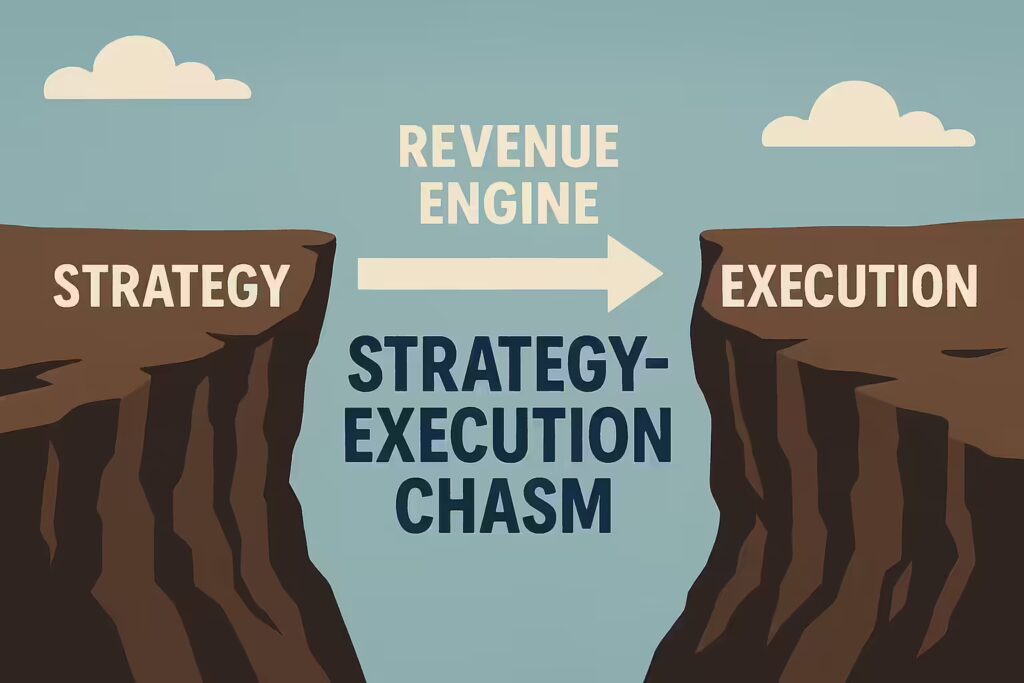 This report will trace the three-stage evolution of revenue technology and strategy. We will start with the foundational Customer Relationship Management (CRM) platform, move through the strategic realignment of Revenue Operations (RevOps), and arrive at the modern necessity of Revenue Orchestration. This analysis will demonstrate that while CRMs provided a database and RevOps offered a blueprint, only a true Orchestration platform provides the intelligent, automated engine required to bridge the gap between insight and action.
The journey will uncover the promises and pitfalls of each stage, revealing how the limitations of one era spurred the innovations of the next. Ultimately, you will have a clear framework to assess your own operational maturity and understand why an intelligent execution layer is no longer a luxury but a critical component for any company serious about succeeding in today’s competitive landscape.
This report will trace the three-stage evolution of revenue technology and strategy. We will start with the foundational Customer Relationship Management (CRM) platform, move through the strategic realignment of Revenue Operations (RevOps), and arrive at the modern necessity of Revenue Orchestration. This analysis will demonstrate that while CRMs provided a database and RevOps offered a blueprint, only a true Orchestration platform provides the intelligent, automated engine required to bridge the gap between insight and action.
The journey will uncover the promises and pitfalls of each stage, revealing how the limitations of one era spurred the innovations of the next. Ultimately, you will have a clear framework to assess your own operational maturity and understand why an intelligent execution layer is no longer a luxury but a critical component for any company serious about succeeding in today’s competitive landscape.
Stage 1: The Foundation – The Age of the CRM (The System of Record)
The Promise of a Single Source of Truth
The arrival of the Customer Relationship Management (CRM) system revolutionized business operations. It promised to rescue companies from the disarray of scattered spreadsheets, isolated inboxes, and siloed departmental knowledge. For the first time, a business could consolidate all its customer information into a single, centralized database, creating a “360-degree view” of each relationship.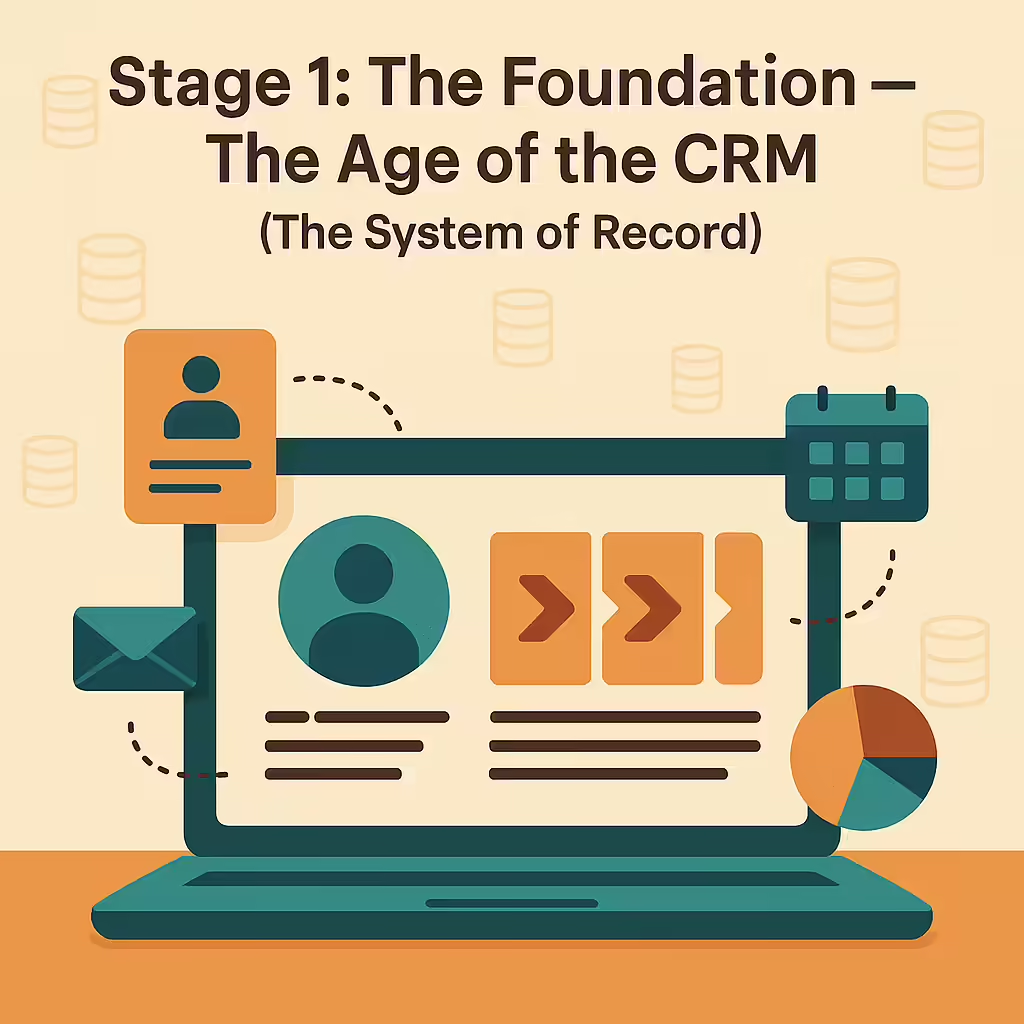 The core functions of the CRM delivered immediate and undeniable value. Contact management organized customer details, communication histories, and preferences. Sales management features allowed leaders to track leads through a visual pipeline, monitor sales activities, and manage opportunities. The CRM became the essential “System of Record,” a centralized platform where all teams—sales, marketing, and customer service—could access the same foundational customer data. This capability enabled basic reporting, improved sales forecasting accuracy, and gave managers a unified view of their pipeline—a significant improvement over the fragmented systems that came before.
The core functions of the CRM delivered immediate and undeniable value. Contact management organized customer details, communication histories, and preferences. Sales management features allowed leaders to track leads through a visual pipeline, monitor sales activities, and manage opportunities. The CRM became the essential “System of Record,” a centralized platform where all teams—sales, marketing, and customer service—could access the same foundational customer data. This capability enabled basic reporting, improved sales forecasting accuracy, and gave managers a unified view of their pipeline—a significant improvement over the fragmented systems that came before.
The Cracks in the Foundation: Why the CRM is No longer Enough
Despite its foundational importance, the very design of the CRM has created inherent limitations that are magnified in today’s fast-paced, signal-rich environment. The system that was once a solution has, for many, become part of the problem.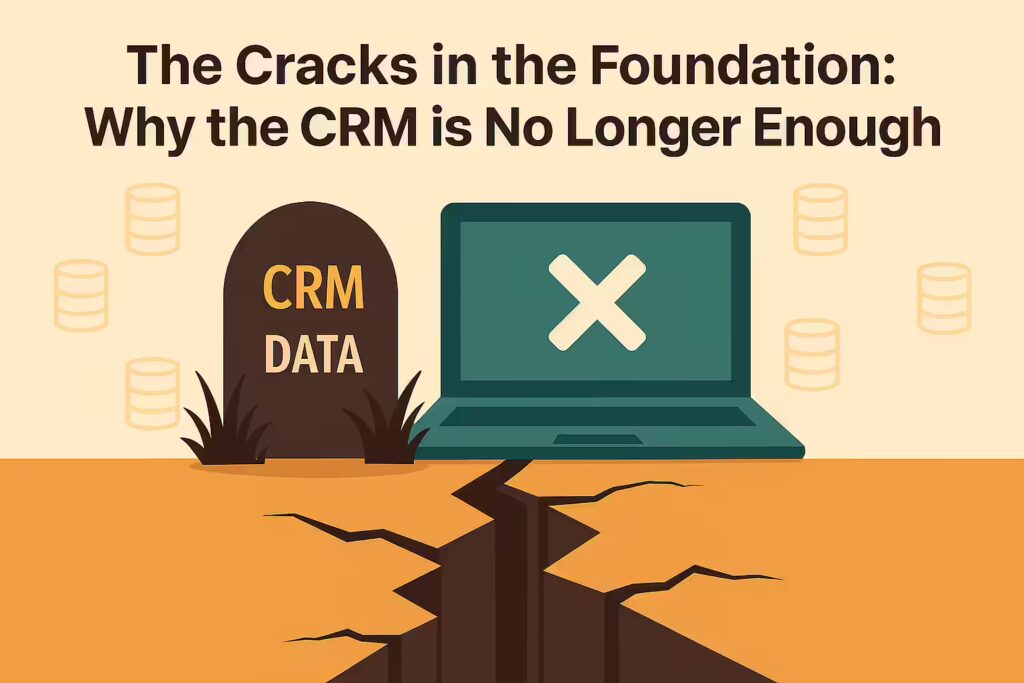
- The Data Graveyard: A CRM is fundamentally a passive database. It’s a system of record, not a system of engagement. Its primary function is to store information that is manually entered by users. Without constant, diligent effort from every team member, this data quickly becomes stale, inaccurate, or incomplete, turning the CRM into a “data graveyard.”
- The Silo Illusion: While CRMs promised to break down silos by centralizing data, they largely failed to unify processes and workflows. Marketing, sales, and customer success teams may look at the same contact record, but they often use a constellation of different, disconnected tools to act on that information. This technological fragmentation creates a disjointed customer experience.
- Passive by Design, Manager-Centric in Practice: Most legacy CRM systems were designed for managers to report on activity, not for sellers to execute it more effectively. They are systems of inspection, demanding that reps spend an inordinate amount of time on administrative tasks and manual data entry instead of selling.
- Integration and Cost Complexity: Enterprise-level CRMs are notoriously complex and expensive to implement, customize, and maintain. Integrating them with an ever-expanding tech stack is a significant challenge, often requiring dedicated IT resources and costly consultants. The dream of a single, unified system quickly devolves into a costly and fragile patchwork of software.
Stage 2: The Strategic Realignment – The Rise of RevOps (The Human-Led Blueprint)
A New Philosophy for Growth
The chaos and inefficiency stemming from a reliance on CRM alone gave rise to a new strategic discipline: Revenue Operations (RevOps). RevOps is not a piece of software but a cross-functional business methodology designed to address the systemic failures of siloed operations. Its core purpose is to align marketing, sales, and customer success into a single, cohesive revenue engine, all working from the same data and toward the same goals.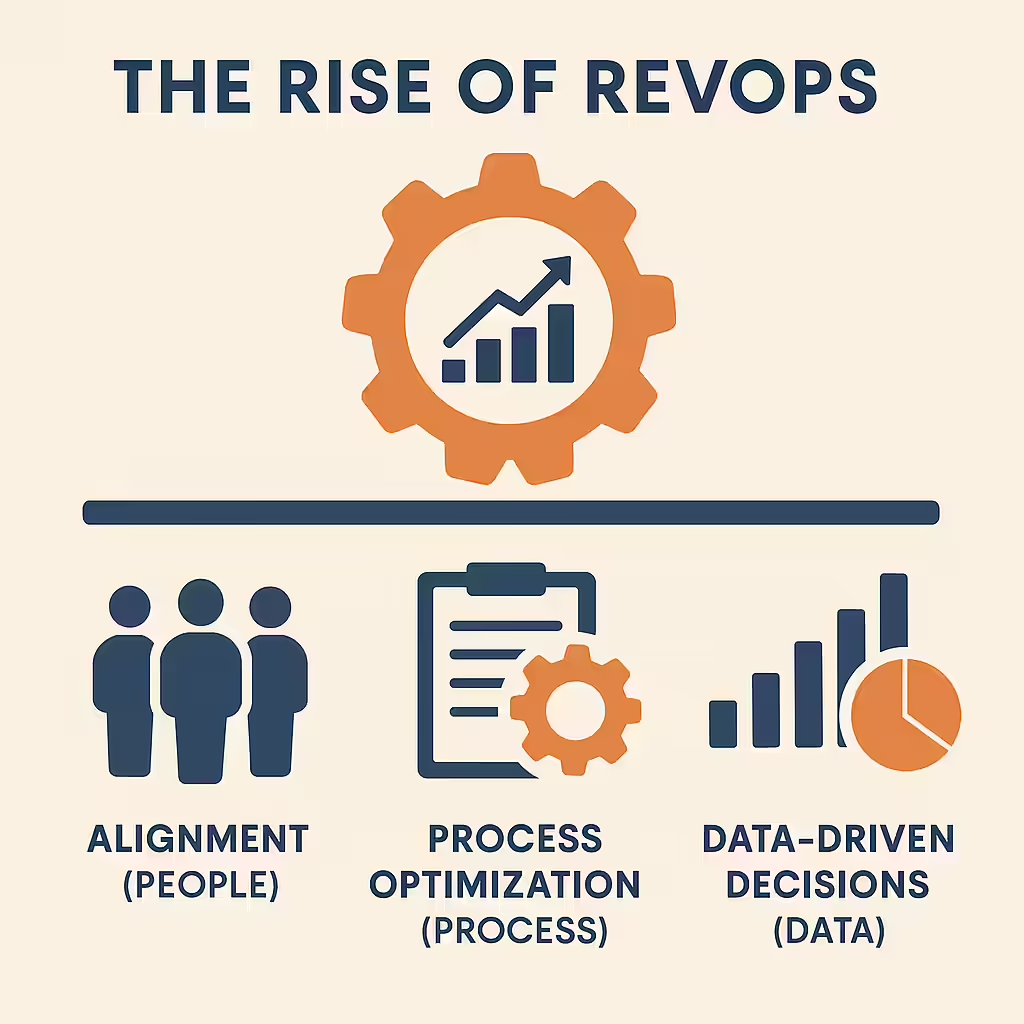
The RevOps Mandate: People, Process, and Data
A successful RevOps function is built on three foundational pillars:- Alignment (People): The primary mandate of RevOps is to break down the organizational silos that create friction. This involves aligning teams, processes, and incentives around shared revenue goals.
- Process Optimization (Process): RevOps teams are responsible for mapping the entire customer journey, identifying bottlenecks, and standardizing workflows to improve efficiency and scalability.
- Data-Driven Decisions (Data): RevOps elevates the conversation from departmental metrics to holistic, business-level KPIs like Customer Lifetime Value (CLV), Customer Acquisition Cost (CAC), and pipeline velocity.
The Strategy-Execution Chasm: Where RevOps Hits a Wall
RevOps provides the brilliant strategic blueprint—the “what” and the “why”—but it often fails at the most critical juncture: the point of execution.- The Fragmented Tech Stack: RevOps leaders often attempt to stitch together dozens of disconnected point solutions, creating data latency and workflow friction.
- From Insight to Action… Manually: Translating a data insight into a specific, automated, real-time action for a rep is nearly impossible with a fragmented stack. The burden of execution still falls on the individual.
- The Limits of Human-Led Operations: RevOps as a strategy relies on humans to enforce processes. This model is not scalable and is inherently prone to error and inconsistency.
Stage 3: The Final Frontier – Full Revenue Orchestration (The Technology-Led Execution Engine)
Defining the Execution Engine
Revenue Orchestration Platforms (ROPs) emerged as the technological answer to the Strategy-Execution Chasm. Coined by Forrester, this new category of technology moves far beyond the CRM’s passive data storage. An ROP is the operational brain and execution engine that unifies the tech stack, synthesizes data, and uses AI to automate and guide the actions of revenue teams in real-time. The fundamental leap is the shift from a top-down, human-enforced process to bottom-up, AI-guided execution.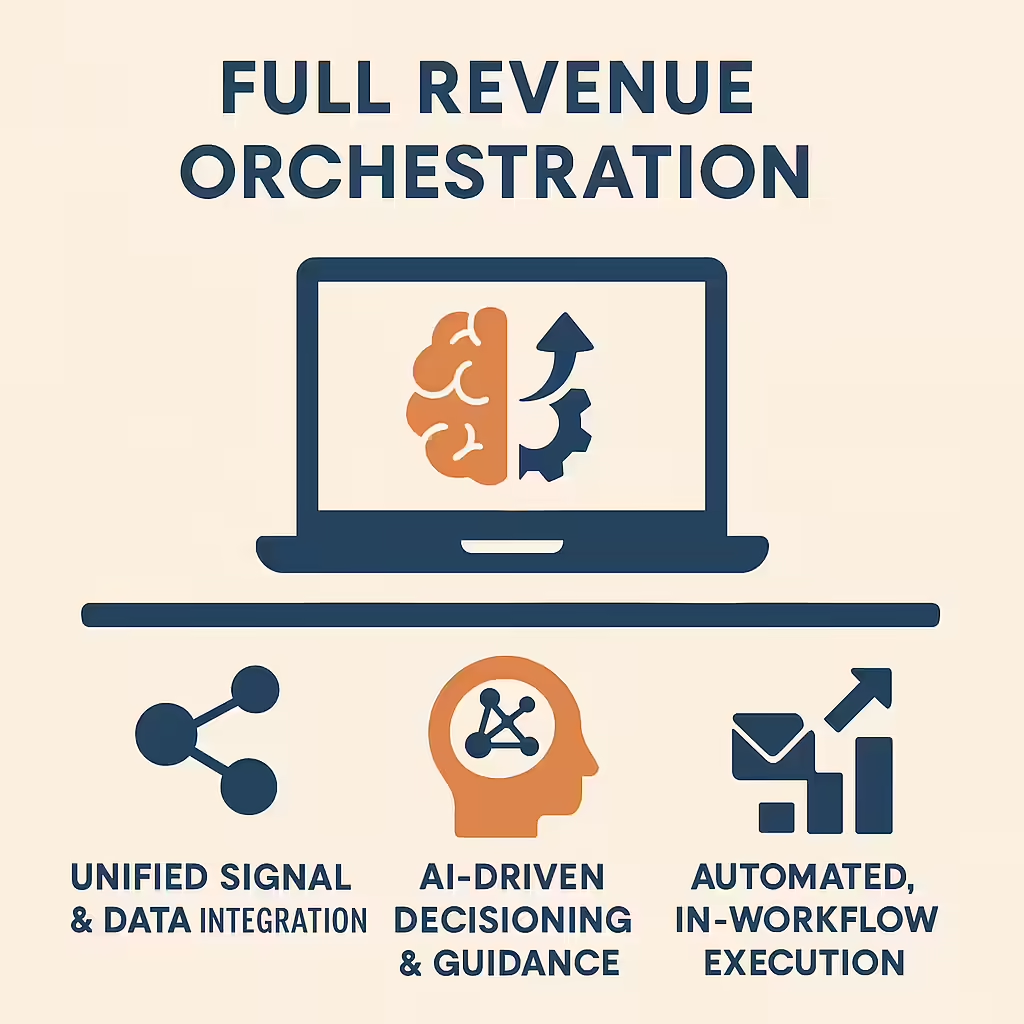
The Three Core Pillars of True Orchestration
- Unified Signal & Data Integration: ROPs ingest and synthesize signals from every customer touchpoint into a single, real-time view of the customer journey, breaking down data silos.
- AI-Driven Decisioning & Guidance: An ROP leverages AI to analyze signals and deliver predictive and prescriptive guidance, answering the question: “What is the most valuable action I can take right now?”
- Automated, In-Workflow Execution: An ROP doesn’t just display an insight; it activates the next best action. It can automatically initiate calls, send messages, or enroll contacts in an engagement cadence based on real-time triggers.
Revenue Orchestration in Action: The Kixie Blueprint
From Theory to Practice: Kixie as the Orchestration Engine
Within the modern ROP stack, Kixie serves as the indispensable Execution and Feedback Layer. While other platforms may focus on data unification or analytics, Kixie is the component that translates intelligence into live customer conversations and automated engagement at scale.Anatomy of an Orchestrated Play (with Kixie)
Consider two scenarios that are impossible to automate effectively without an execution engine like Kixie.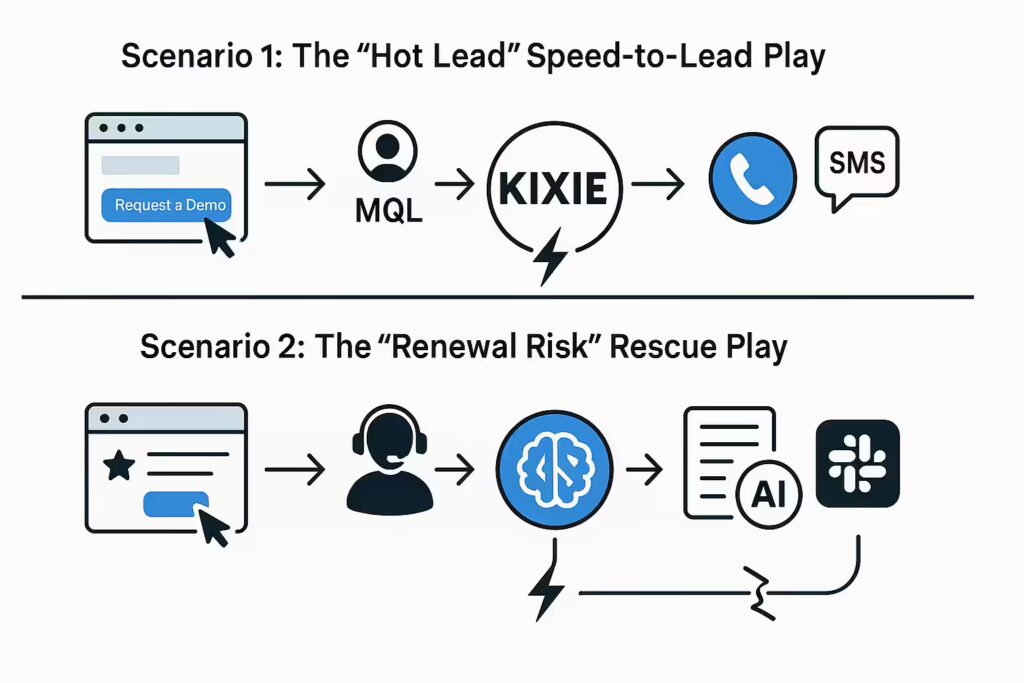 Scenario 1: The “Hot Lead” Speed-to-Lead Play
Scenario 1: The “Hot Lead” Speed-to-Lead Play
- Signal: A high-value prospect submits a “Request a Demo” form on your website.
- Intelligence: The system identifies the lead as an MQL from a target account.
- Kixie’s Orchestrated Execution: A webhook instantly triggers Kixie’s automation to place the lead in a high-priority queue. The AI PowerDialer auto-dials the first available rep using a local area code to increase answer probability. If unanswered, a pre-recorded voicemail and a personalized SMS are automatically sent, with all activities logged back to the CRM.
- Signal: A customer’s health score in the CRM drops below a critical threshold.
- Intelligence: The system flags the account as a high-priority churn risk.
- Kixie’s Orchestrated Execution: An automated trigger creates an urgent task in the CSM’s Kixie PowerCall dialer. During the call, Conversation Intelligence can surface sentiment from past interactions. Afterward, an AI-generated summary is pushed to the CRM, and alerts for keywords like “competitor” are sent to management via Slack.
Validating the Model: Real-World Results
The power of this orchestrated approach is validated by tangible business outcomes achieved by Kixie customers.- Fischer Homes tripled its outbound call volume by deploying Kixie’s multi-line AI PowerDialer.
- Solar Power Pros cut appointment no-shows by 50% using Kixie’s dialer and automated SMS reminders, significantly increasing monthly revenue.
- A fast-growing e-commerce business slashed its lead response time to under 5 minutes with Kixie’s Intelligent Lead Routing, driving a 20% improvement in lead conversion.
Are You Just Operating, or Are You Ready to Orchestrate?
The evolution of revenue technology has been a relentless march away from fragmentation and toward intelligent integration. The CRM provided a static record, while RevOps offered a strategic blueprint. However, both left a significant chasm between insight and action. Revenue Orchestration is the bridge across that chasm. It is the culmination of this evolution, powered by an intelligent execution engine that finally connects strategy to real-world engagement. This brings every revenue leader to a critical inflection point. Is your team still operating—manually reacting to stale data? Or are you ready to orchestrate—proactively guiding every customer interaction and automating execution? The choice is between unpredictable results and predictable growth. Kixie provides the engine to power true orchestration, turning your revenue strategy into conversions.Frequently Asked Questions
What exactly is a CRM (Customer Relationship Management) system?
A CRM system is a software tool designed to manage and analyze all interactions a business has with its existing and potential customers. It acts as a centralized database for customer information. The primary goal of a CRM is to improve customer relationships, assist with retention, and drive sales growth.What is Revenue Orchestration (RO)?
Revenue Orchestration is a strategic, integrated approach that coordinates all marketing, sales, and customer success activities across the entire buying journey. A Revenue Orchestration Platform (ROP) is technology that enables B2B teams to design, execute, capture, analyze, and improve customer engagement while optimizing internal revenue processes.How are CRM and Revenue Orchestration related? Are they the same thing?
CRM and Revenue Orchestration are not the same, but they are closely related and complementary concepts.
- A CRM typically functions as your “system of record,” the foundational database for customer information.
- Revenue Orchestration is an advanced layer that works with your existing CRM to automate and coordinate workflows and data across teams.
- ROPs enhance what a CRM already does by unifying data and layering AI-driven insights to reveal gaps and opportunities.
What are the main benefits of a CRM?
- Better Customer Relationships: Provides a 360-degree view of customer history.
- Increased Sales & Productivity: Automates repetitive administrative tasks.
- Centralized Data & Organization: All information is stored in one accessible location.
- Improved Collaboration: Acts as a single source of truth for all departments.
- Enhanced Marketing: Supports targeted campaigns and customer segmentation.
- Better Forecasting: Offers tools for analyzing trends and generating revenue forecasts.
- Scalability: Designed to grow with your business.
What specific problems does Revenue Orchestration solve?
- Fragmented Processes: Eliminates operational silos between sales, marketing, and customer success.
- Messy Handoffs: Smooths transitions between teams, reducing lead leakage.
- Lack of Data Trust: Pulls data into a single, reliable source of truth.
- Inaccurate Forecasting: Provides advanced forecasting tools based on real-time activity.
- Slow Sales Cycles: Automates tasks and guides reps on “next-best actions.”
- Disjointed Tech Stacks: Connects disparate tools into a unified system.
- Inconsistent Customer Experience: Ensures customers receive a seamless, personalized experience.
How does AI play a role in CRM and Revenue Orchestration?
- In CRM: Modern CRMs leverage AI to automate routine tasks, surface customer insights, and accelerate growth, with features for generating email copy, analyzing sales performance, and automating data entry.
- In Revenue Orchestration: AI is a core component. AI-driven ROPs automate revenue processes, use AI to process buyer signals to deliver “next best actions,” and analyze conversations for deep insights.
Do I need a traditional CRM if I implement a Revenue Orchestration Platform?
Yes, in most cases. Your CRM continues to serve as your fundamental “system of record.” ROPs are typically designed to integrate with and enhance your existing CRM rather than replace it. This integration leverages the strengths of both systems without requiring a disruptive CRM migration.Who typically benefits most from CRM versus Revenue Orchestration?
CRM benefits are broad and applicable to many:
- Businesses of all sizes seeking to organize data and improve efficiency.
- Sales, marketing, and customer service teams.
- Nonprofit organizations.
- GTM Teams looking for enhanced cross-functional alignment.
- Chief Revenue Officers (CROs) who require holistic visibility and predictable growth strategies.
- Account Executives (AEs) and Sales Reps aiming to reduce administrative burdens.
- Revenue Operations (RevOps) Teams managing the technology that drives revenue.
- Organizations struggling with data fragmentation and manual processes.


